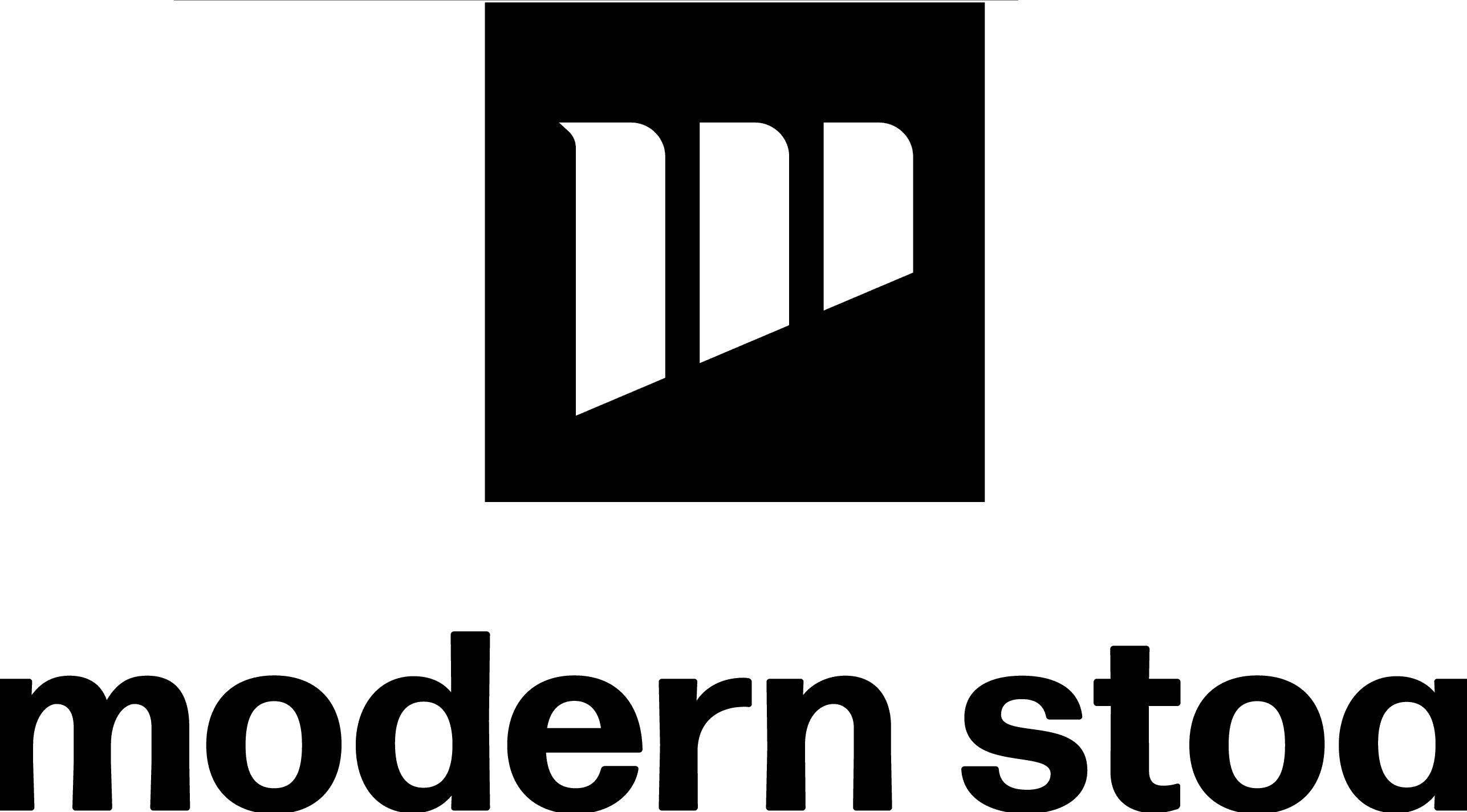Top 5 Mistakes to Avoid When Going Live for the First Time
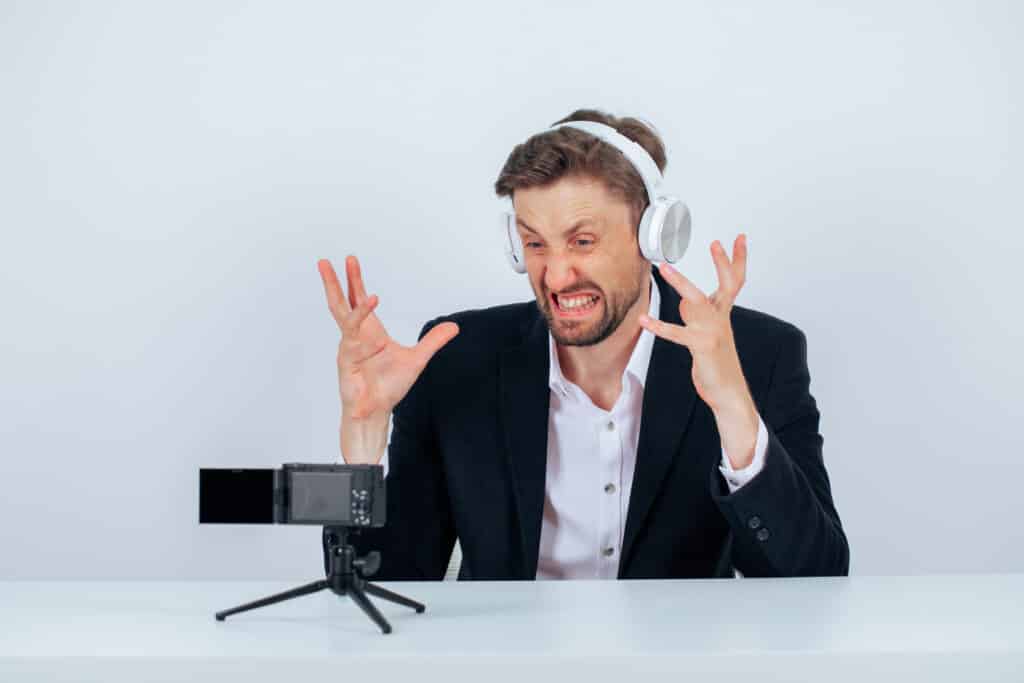
Going live can be exciting, but it also brings a unique set of challenges, especially for first-timers. Without preparation, small issues can snowball and affect the viewer experience. The good news? Most early mistakes are easy to fix with a little planning. Here are five of the most common errors new streamers make, and how to avoid them.
1. Skipping a Tech Check
One of the most preventable problems is going live without testing your setup. Audio that cuts out, laggy video, or unstable internet can lose viewers fast. Before streaming, test your microphone, camera, and internet speed. Use a private or unlisted stream to make sure everything looks and sounds right. If you’re streaming with guests, do a quick test call beforehand to iron out any tech issues early.
2. Poor Camera Framing or Lighting
Viewers form first impressions quickly. A messy background, dim lighting, or awkward camera angle can be distracting. Place your camera at eye level and make sure your face is well lit. A clean background or a branded space adds professionalism. If you’re using natural light, try to face a window. For low-light setups, consider adding a soft ring light or desk lamp to enhance your visibility.
3. Ignoring the Live Chat
One of the biggest advantages of live streaming is the chance to connect with viewers in real time. Ignoring the chat or not acknowledging it at all can make your stream feel distant. Even a small comment like “Thanks for joining!” helps create a sense of community. If your audience grows, consider assigning a friend or moderator to help monitor the chat and flag questions.
4. Starting Without a Plan
Going live without a clear outline can lead to rambling or awkward pauses. You don’t need a full script, but a simple structure helps keep things on track. Know how you’ll open the stream, what key points or segments you want to cover, and how you’ll wrap things up. Having talking points nearby gives you a fallback if nerves hit or momentum dips.
5. Forgetting to Promote the Stream
Even the best stream will struggle to gain traction without promotion. Share your stream link ahead of time on your social channels, email list, or community platforms. Remind people when and where to tune in. Platforms like Instagram Stories or countdown posts on Twitter or LinkedIn can boost awareness before you go live.
Final Thoughts
The first time you go live can feel intimidating, but it doesn’t have to be overwhelming. With a few simple adjustments, testing your gear, framing your shot, engaging with your audience, and planning your flow, you’ll build confidence and deliver a better experience. Every live session is a chance to improve, so start small, stay consistent, and keep learning as you go.
Looking to take your podcast to the next level? Book a session at Modern Stoa Podcast Studio. Go to modernstoa.co/studio.
Designing Interactive Podcast Experiences with Listener Engagement Tools

Podcasting has always been a personal medium, but new tools are helping creators make it more interactive than ever. By turning passive listeners into active participants, podcasters can boost engagement, build loyalty, and create episodes that feel like a conversation, not just a broadcast. From polls to voice replies, the options for audience involvement keep growing.
Polls and Q&A: Instant Feedback in Real Time
Many podcast platforms now allow creators to embed polls or questions directly into their episodes. Spotify, for example, lets listeners vote on episode-specific questions or leave written responses. These tools are easy to set up and offer quick insights into what your audience thinks, wants more of, or finds most valuable.
Use polls to decide future topics, vote on guest preferences, or reflect on questions posed during the episode. These small moments of input help listeners feel seen and heard.
Choose-Your-Own-Adventure Style Episodes
One creative format that’s gaining traction is branching narrative episodes, where listeners choose the direction of the story. This can be done through linked episode segments, dynamic ad tools, or playlist sequencing. While this takes extra planning, it’s an excellent way to build deeper immersion, especially for fiction, true crime, or learning-based shows.
To keep it simple, you can start with a “Part A or Part B” setup, where your audience votes on what they want to hear next. Then follow up with the most-requested direction in a future episode.
Voice Replies and Listener Messages
Services like SpeakPipe, PodInbox, and Spotify’s voice note tools allow listeners to leave voice replies or questions directly for the host. You can feature these replies in future episodes, creating a call-and-response structure that keeps listeners coming back to hear their contribution.
This format works especially well for advice shows, Q&A sessions, and community-driven series. Just make sure you ask clear questions and set a deadline so listeners know when and how to participate.
Live Listener Input and Reactions
If your podcast also streams live or includes livestream events, you can bring in real-time listener input using chat, polls, or reaction features. Live Q&As, post-episode discussions, and audience AMA sessions add a new layer of energy and make your content feel like a shared experience.
You can also record these events and feature highlights in your main feed, allowing non-live listeners to benefit from the interactivity even after the fact.
Final Thoughts
Interactive podcasting isn’t just about gimmicks, it’s about making your audience feel like part of the process. Whether you use voice messages, embedded polls, or live chat tools, every small point of interaction builds trust and strengthens the connection between host and listener. Start with one interactive element, see how your audience responds, and continue from there.
Looking to take your podcast to the next level? Book a session at Modern Stoa Podcast Studio. Go to modernstoa.co/studio.
Choosing the Right Gear for Mobile Live Streaming
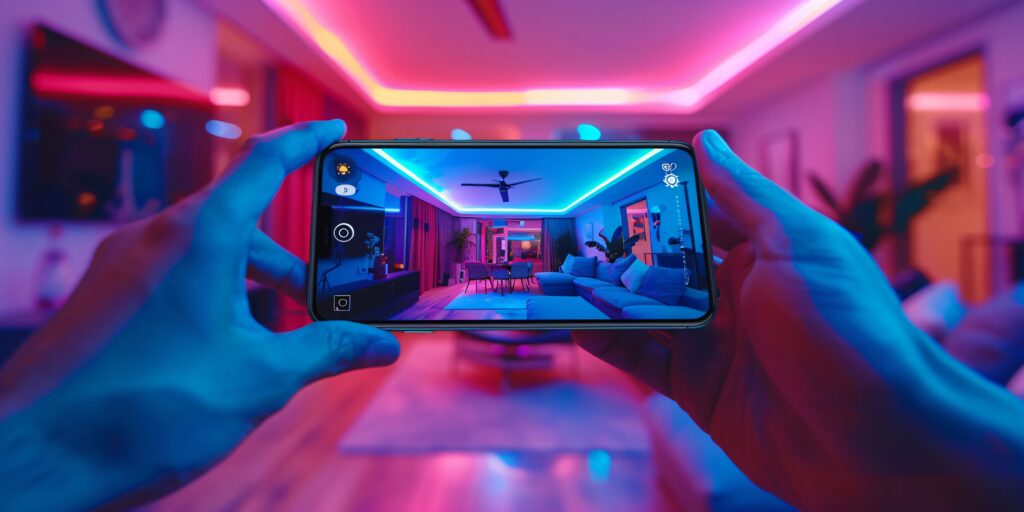
Going live from your phone has never been easier, but doing it well takes more than just tapping “Go Live.” Whether you’re streaming from a crowded event, a city street, or a quiet park, having the right mobile gear can make or break your stream. A stable image, clear audio, and reliable power are essential to keeping your viewers engaged. Here’s a quick guide to building a simple, effective mobile live streaming kit that travels with you.
Smartphone Selection: Stability, Clarity, and Battery Life
Not all phones are built equally when it comes to live streaming. Look for devices with strong camera performance in both bright and low-light environments. Many recent iPhones and flagship Android devices like the Samsung Galaxy S and Google Pixel series offer excellent video quality and solid stabilization features.
Also consider thermal performance and battery life. Live streaming is demanding on your device, so phones with efficient processors and advanced heat management will avoid mid-stream shutdowns or lag.
Microphones: Clean Audio on the Go
Your stream can survive average video, but not poor audio. Built-in mics often pick up background noise, making it hard for viewers to focus. External microphones solve this problem and give your content a more professional feel.
Lavalier mics (clip-on style) are great for mobile use, especially for interviews or vlogging. Compact shotgun mics that mount directly to your phone or case are another strong option. Look for models that connect via USB-C, Lightning, or 3.5mm depending on your phone’s port.
Tripods and Stabilizers: Keep It Steady
Shaky footage is distracting, especially on small screens. A lightweight tripod or handheld gimbal will instantly improve your visual quality. Tripods with adjustable legs are useful for uneven surfaces or impromptu setups. Gimbals add smooth motion for walking shots or panning around a scene.
If you’re shooting alone, consider a tripod with a Bluetooth remote or timer feature to help you manage camera angles without touching your phone.
Power Backups: Don’t Let Your Stream Die Early
Live streaming drains batteries fast. A portable power bank is a must-have if you plan to stream longer than 20–30 minutes. Choose one with fast-charging capability and enough capacity to recharge your device at least once.
Mountable power banks or charging phone cases can help keep cables out of the way while you move, especially during handheld shoots or roaming interviews.
Final Thoughts
Mobile live streaming gives creators the freedom to share content from anywhere, but that freedom depends on preparation. With the right smartphone, audio gear, stabilization, and power support, you can stream confidently and professionally without a studio setup. Whether you’re on the street or at an event, a portable kit helps you stay nimble while still delivering high-quality content.
Looking to take your podcast to the next level? Book a session at Modern Stoa Podcast Studio. Go to modernstoa.co/studio.
The Psychological Impact of Voice and Sound Design in Podcasts

Podcasts have a unique ability to create intimacy, emotion, and focus, often with just a voice and a well-placed sound cue. Unlike visual media, audio doesn’t compete with images for attention. Instead, it guides the listener’s imagination. The tone of a host’s voice, the pacing of delivery, and the overall sound design all play a key role in how a podcast is received and remembered.
Understanding the psychology behind sound can help podcasters design experiences that feel intentional and emotionally resonant, without manipulating or overwhelming the listener.
Timbre and Emotional Connection
Timbre refers to the unique quality or “color” of a voice. A warm, calm vocal tone can create a sense of trust and comfort. A sharper, more energetic delivery may signal urgency or excitement. Listeners often form subconscious opinions about a host within seconds based on vocal characteristics alone.
Podcasters can shape timbre through mic choice, recording environment, and post-production processing. While voice quality varies naturally from speaker to speaker, using EQ to gently reduce harsh frequencies or add warmth can subtly enhance emotional connection.
Pacing and Attention Span
How fast or slow someone speaks significantly affects listener engagement. A slower pace can help listeners absorb complex topics, while a faster tempo creates energy and momentum. However, consistency matters. Abrupt changes in speed without purpose can confuse or distract.
Strategic pauses also give listeners space to reflect or anticipate. Many narrative podcasters use this intentionally to build tension or let a key moment land. When used thoughtfully, pacing becomes a storytelling tool that matches the rhythm of the message.
Frequency Balance and Listener Comfort
Listeners may not consciously notice the frequency mix of an episode, but their brains respond to it. Excessive bass can feel heavy or oppressive, while overly bright mixes may cause listener fatigue over time. A well-balanced frequency spectrum ensures the audio is pleasant and sustainable for long-form listening.
Simple adjustments, like taming harsh sibilance or balancing vocal presence, make a big difference. Using reference tracks or trusted headphones during mixing helps producers ensure their podcast sounds clear and comfortable across devices.
Ambient Sound and Emotional Cues
Soundscapes and subtle background elements can create a vivid sense of space or mood. A quiet forest, soft rain, or distant city noise can transport the listener without overpowering the core dialogue. These cues support storytelling and tone but should be used with care.
Overuse of ambient elements can shift focus or cause confusion. Ethical sound design respects the listener’s attention and emotions, using audio cues to enhance the experience. Clarity and consent should always guide creative choices, especially when dealing with suspense, trauma, or emotionally intense topics.
Final Thoughts
Every voice and sound choice in a podcast has the potential to influence how the listener feels, thinks, and remembers. By understanding the psychological effects of timbre, pacing, frequency, and ambiance, podcasters can craft more immersive, engaging, and emotionally grounded shows.
Great sound design is not about complexity. It’s about intentionality. When producers match technical skill with empathy, the result is audio that truly resonates.
Looking to take your podcast to the next level? Book a session at Modern Stoa Podcast Studio. Go to modernstoa.co/studio.
Sustainability Best Practices in Podcast Production and Merch
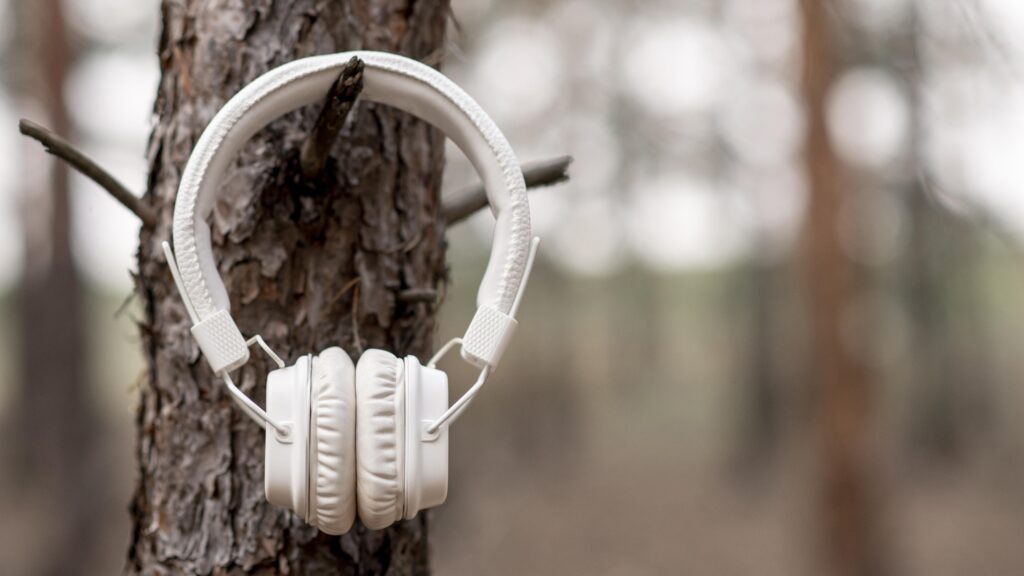
As podcasting grows, so does its environmental footprint. From digital storage to branded merchandise and global shipping, production decisions can quietly accumulate impact. The good news is that podcasters have real options to reduce waste, support eco-friendly practices, and build deeper trust with environmentally conscious listeners.
Reducing the Footprint of Your Production
Podcasting may seem low-impact compared to video, but digital production still uses energy, from cloud storage to streaming platforms and device usage. Start by evaluating your workflow. Can you batch-record to reduce file transfers and storage needs? Are your hosting and editing tools powered by renewable energy?
Choosing a podcast host that supports green data centers or carbon offsetting can make a measurable difference. You can also reduce emissions by limiting unnecessary re-uploads, storing archived audio locally, and optimizing file sizes for efficient delivery.
Eco-Friendly Merch Matters More Than You Think
Merch is one of the most visible extensions of your podcast brand, and it’s often the first thing fans buy. But t-shirts, stickers, and tote bags can carry hidden environmental costs. Look for vendors that offer organic or recycled materials, use water-based inks, and follow ethical labor practices.
On-demand merch platforms help reduce overproduction and wasted inventory. If possible, offer digital alternatives like downloadable posters or bonus content to give fans ways to support the show without physical goods.
Smarter Shipping and Packaging Choices
Shipping has a surprisingly high carbon cost, especially when items are sent individually across long distances. Choosing vendors that offer regional production and fulfillment can help minimize emissions. Encourage bulk orders or bundle merch drops to reduce the number of shipments.
Avoid plastic-heavy packaging by opting for compostable mailers, recycled boxes, or minimalist packaging that still feels branded. Many vendors now offer low-waste options without sacrificing design or protection.
Communicate Your Efforts with Honesty
Sustainability can be a powerful message, but only when it’s real. Be transparent about what steps you’re taking and where you’re still working to improve. Listeners appreciate progress over perfection. Share your journey in show notes, website pages, or even in-episode updates.
Avoid vague terms like “eco-friendly” without context. Instead, explain specific actions: using certified materials, switching to green hosting, or offsetting your merch delivery. Clear messaging builds credibility and helps set expectations with your audience.
Final Thoughts
Building a more sustainable podcast brand is not only possible, it’s increasingly expected. With thoughtful choices in production, merch, and communication, podcasters can reduce their environmental impact while staying true to their mission. Even small steps can lead to meaningful change when applied consistently and shared authentically.
Looking to take your podcast to the next level? Book a session at Modern Stoa Podcast Studio. Go to modernstoa.co/studio.
Podcast Accessibility: Beyond Transcripts to Inclusive Experiences

Podcasting is often celebrated as an open medium, but many shows still fall short of being truly accessible. While transcripts are an important starting point, they are only one piece of a broader effort to make podcasts more usable and inclusive for everyone. Whether your audience includes listeners who are deaf, hard of hearing, neurodivergent, or non-native speakers, small accessibility improvements can go a long way toward expanding your reach and deepening engagement.
Start with More Than Just a Transcript
Transcripts are essential, but not all transcripts are created equal. Simply generating auto-text from an app may technically meet basic accessibility standards, but quality matters. Clean formatting, speaker labels, timestamps, and edited grammar improve readability and comprehension. Consider enhancing your transcripts with headings, links, or summaries to give more context and navigation support for readers. If your show includes complex concepts, multiple voices, or non-verbal sounds, including brief notes on tone or sound effects can also provide helpful cues for those reading instead of listening.
Add Captions for Video Podcasts and Social Clips
If you’re sharing video episodes or short clips on platforms like YouTube, TikTok, or Instagram, captions are non-negotiable. Captions help people understand your content in noisy environments, and more importantly, they make your show accessible to those who cannot hear. Use burned-in (open) captions to ensure readability across platforms, and double-check accuracy, especially with names, jargon, or industry terms. Many tools now allow for easy caption generation, but it’s worth taking the time to review and edit them. Captions that are rushed or incorrect can create confusion and frustrate viewers.
Make Your Content Understandable for a Wider Range of Listeners
Plain-language summaries are a helpful addition for listeners who may process information differently, including neurodivergent users or those with limited English proficiency. These summaries break down complex ideas into simpler language and can be added to your show notes, website, or even read aloud at the beginning or end of an episode.
For fictional or immersive shows, audio descriptions can be used to briefly explain key visual or spatial elements. While not every show requires this level of detail, being thoughtful about how your audience understands the full context is a step toward more inclusive storytelling.
Choose Platforms That Support Accessibility Features
Not all podcast platforms support the same accessibility tools. When promoting your show, prioritize platforms that offer easy access to transcripts, adjustable playback speeds, captioned video (if relevant), and user-friendly interfaces for screen readers. Also consider your own website. Is it navigable with keyboard-only controls? Are the fonts legible and contrast levels sufficient? Small changes in layout and design can greatly improve the experience for listeners with visual or cognitive challenges.
Final Thoughts
Accessibility in podcasting is not just about compliance, it’s about respect. Taking the time to improve your show’s usability helps you reach more people and makes your content better for everyone. When creators think beyond transcripts and approach accessibility as part of the core experience, they unlock new ways to connect with audiences who are often overlooked.
Looking to take your podcast to the next level? Book a session at Modern Stoa Podcast Studio. Go to modernstoa.co/studio.
Incorporating Virtual Reality and Augmented Reality in Podcasts

Podcasting has always been about imagination, creating a story, a conversation, or an idea that unfolds entirely in a listener’s mind. But as technology evolves, so does the opportunity to enhance that experience. Today, podcasters are starting to experiment with virtual reality (VR) and augmented reality (AR) to add new dimensions to their shows, turning audio into immersive environments that extend far beyond headphones.
Creative Use Cases for VR and AR in Podcasting
VR and AR don’t replace traditional podcasting. Instead, they offer companion experiences that deepen engagement. A true crime podcast, for example, might include a VR walkthrough of a key scene. An educational show could offer an AR overlay where listeners scan a page or object to reveal 3D visuals that match the topic. For fiction podcasts, spatialized audio and immersive environments allow listeners to step directly into the world of the story.
Live events are another area where these tools shine. Through AR, audiences can experience interactive overlays at live tapings or exhibits. In VR, fans could attend virtual venues, meet characters, or explore narrative environments. These experiences are especially compelling for communities built around serialized storytelling or genre-specific content.
Making It Sound Immersive
One of the most practical applications of immersive tech in podcasting is spatialized audio, the technique of placing sound in 3D space around the listener. This is commonly used in gaming and film, but it works beautifully in narrative audio as well. Spatial sound can give listeners the feeling of being in the middle of a scene rather than on the outside of it. Many creators are already using binaural recording techniques to simulate these effects without needing a headset.
For VR integration, spatial audio helps align what a listener hears with what they see in a headset. For AR, it provides sonic cues that can complement interactive or location-based visuals.
Technical and Distribution Considerations
Building VR or AR extensions to a podcast doesn’t require recreating your entire show in 3D. Many creators start with one-off episodes or companion apps. Platforms like Unity or WebAR tools allow developers to build lightweight AR layers that run on mobile devices without special hardware. For distribution, creators can embed links to AR experiences in show notes or QR codes on social media.
That said, it’s important to maintain accessibility. Always design immersive features as enhancements, not requirements. Your core show should still stand on its own, with immersive tools serving as an optional layer for those who want to dive deeper.
Final Thoughts
Virtual and augmented reality are still emerging in podcasting, but they’re already opening up new creative paths for engagement and storytelling. From spatial audio to interactive extensions, these tools offer fresh ways to connect with audiences in a world where attention is harder to earn. As immersive tech becomes more mainstream, the podcasters who experiment early will be best positioned to create experiences that are not just heard, but truly felt.
Looking to take your podcast to the next level? Go to modernstoa.co.
DIY Podcast Studio Setup for Small Spaces
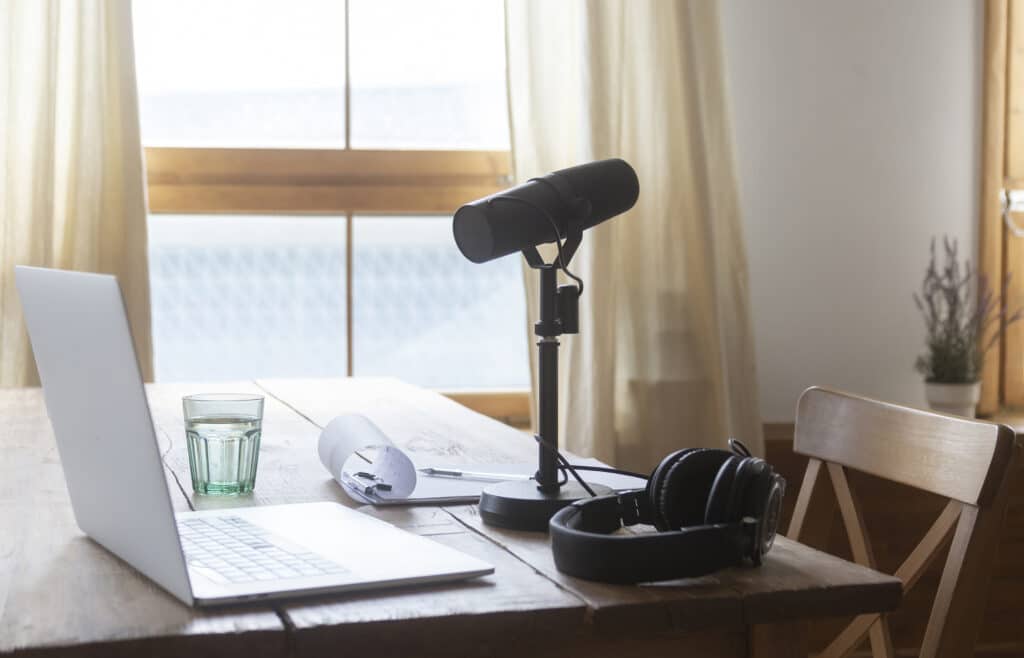
With the right equipment and a few smart layout choices, even a closet, corner, or spare room can become a reliable podcast recording space. Whether you’re producing solo episodes, interviews, or remote calls, a compact setup can deliver excellent results with a little intention.
Make Sound a Priority, Not Size
Before anything else, focus on your acoustic environment. Hard surfaces and bare walls cause unwanted reflections that can make your audio sound harsh or echoey. Soft materials are your friend. Use foam panels, moving blankets, or even thick curtains to absorb sound. A small space like a closet filled with clothes already provides decent sound treatment, making it an ideal starting point for budget-conscious creators. If you’re working in a corner or open room, try placing a rug on the floor and some absorption behind your mic. Even a few well-placed panels can make a noticeable difference.
Choose the Right Mic and Place It Correctly
In tight spaces, a dynamic microphone is usually the best choice. Models like the Shure SM58 or Rode PodMic are affordable, durable, and great at rejecting background noise. Position the mic about 6 to 8 inches from your mouth, angled slightly off-axis to reduce plosives and harsh consonants. Use a boom arm or desk-mounted stand to keep the mic stable without cluttering your workspace. Pop filters are helpful, but in smaller areas, technique and mic placement often matter more than accessories.
Monitor and Manage the Setup Efficiently
Use closed-back headphones to monitor your audio without feedback or sound leakage. A basic audio interface or USB mic with real-time monitoring ensures you can hear problems while recording, not after. Cable management is often overlooked in small setups but goes a long way in creating a clean, usable workspace. Velcro ties, cable clips, and adhesive mounts can keep things tidy, especially if you’re working in a shared room or multi-use area.
Final Thoughts: From Home Setup to Studio-Level Quality
A polished podcast doesn’t require a professional studio, it just requires planning and attention to detail. With smart gear choices, good mic technique, and basic sound treatment, even the smallest space can sound clear and professional.
That said, if you’re ready to take your production to the next level without the limitations of a home setup, Modern Stoa’s podcast studio offers a fully equipped, sound-treated environment designed specifically for creators. Whether you’re recording interviews, series launches, or audio campaigns, our space gives you everything you need to sound your best, with zero guesswork.
Looking to take your podcast to the next level? Book a session at Modern Stoa Podcast Studio. Go to modernstoa.co/studio.
Building and Managing a Podcast Production Team
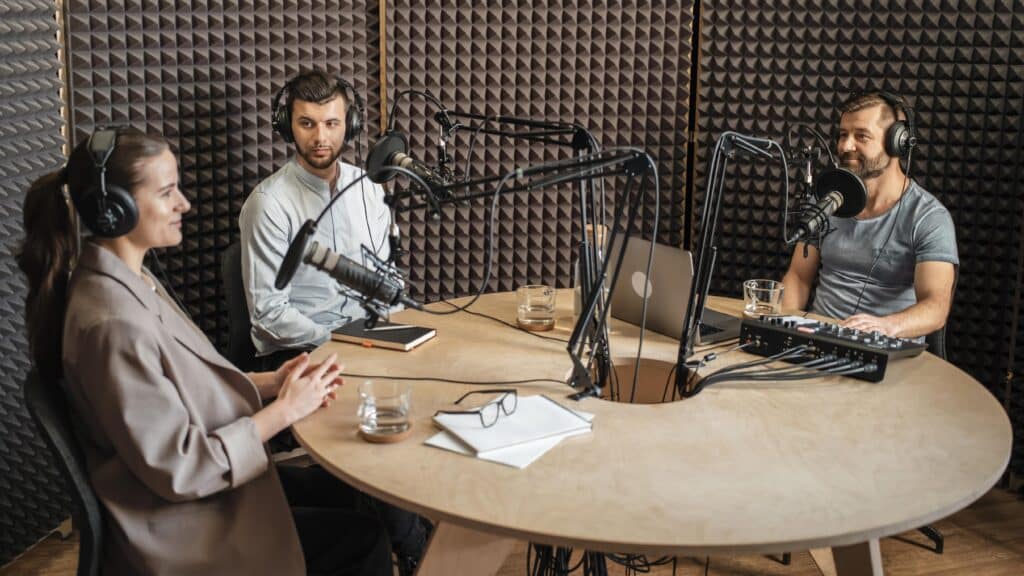
As your podcast grows, managing everything alone, recording, editing, publishing, marketing, can become overwhelming. To scale without losing the soul of your show, building a production team is the logical next step. With the right structure and tools, you can expand output, maintain quality, and stay focused on what you do best: delivering great content.
Defining the Core Roles
Before hiring, it’s important to define the essential roles that make up a functioning podcast team. At a minimum, this often includes an audio editor, show producer, and graphic designer. As you grow, you may also bring in writers, social media managers, or booking coordinators.
A producer manages the production calendar, coordinates with guests, and oversees deadlines. If you’re publishing across platforms, a copywriter can create show notes, blog content, and email newsletters. Each role should have a clear purpose and expectations tied to your workflow.
Hiring: Contractors vs. Employees
For most podcasts, starting with contractors makes sense. Freelancers bring flexibility and lower overhead, especially if your show isn’t producing daily content. Sites like Upwork, Fiverr Pro, and specialized podcast production agencies offer access to experienced professionals.
However, if you’re producing multiple shows, running a branded podcast, or releasing high-frequency content, hiring part-time or full-time employees may provide more consistency and long-term commitment. Consider your goals and budget carefully. A hybrid model often works well, using employees for core operations and contractors for specific tasks like audio mixing or motion graphics.
Setting Up a Scalable Workflow
Once your team is in place, defining a repeatable workflow is key to efficiency. Start by building a production timeline that outlines each step from pre-production through publishing. Break the process down into trackable phases: planning, recording, editing, approvals, and release.
Use project management tools to keep things organized. Platforms like Trello, Asana, ClickUp, or Notion allow you to assign tasks, set deadlines, and communicate in one place. A shared folder system for assets (Google Drive, Dropbox, or Frame.io) helps centralize files for faster handoffs between team members.
Maintaining Quality and Show Consistency
As more people work on your show, quality control becomes essential. This guide can include intro and outro scripts, music usage, preferred transitions, and brand voice notes.
Schedule regular team check-ins to review recent episodes, gather feedback, and discuss upcoming content. Encourage editors and producers to flag anything that feels off-brand or inconsistent. Protecting the voice of your show doesn’t mean limiting creativity—it means creating guardrails that allow your team to produce confidently and consistently.
Final Thoughts
Building a podcast production team allows you to grow without sacrificing quality or losing the unique voice that makes your show resonate. With clearly defined roles, the right balance of freelance and in-house help, structured workflows, and quality control systems, you can scale your podcast and maintain creative control. Growth doesn’t mean doing everything yourself, it means building a system that lets your vision thrive.
Looking to take your podcast to the next level? Book a session at Modern Stoa Podcast Studio. Go to modernstoa.co/studio.
Advanced Remote Interview Techniques for Podcasting
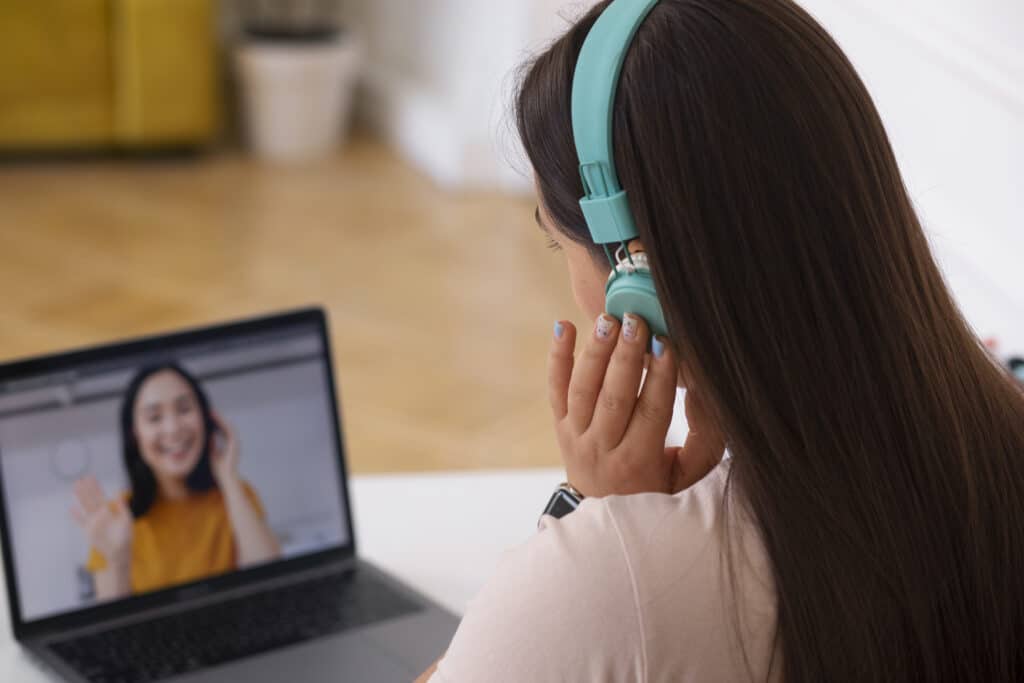
Remote interviews are now a core part of modern podcasting. They expand access to guests, reduce production costs, and allow shows to stay consistent regardless of location. But they also introduce technical and conversational challenges that, if not addressed, can compromise the listening experience. With the right tools and techniques, you can deliver studio-quality conversations, even when your guest is halfway across the world.
Prioritizing Low Latency for Natural Dialogue
One of the biggest issues in remote interviews is latency. Even small delays can throw off the rhythm of a conversation and cause awkward overlaps. Tools like Riverside, SquadCast, and Cleanfeed offer low-latency, browser-based solutions that preserve the natural back-and-forth between host and guest. Unlike Zoom or Skype, which prioritize video and often compress audio quality, these platforms are built for podcasters and optimized for spoken word.
To improve flow even further, conduct a quick pre-interview test call. This helps both you and your guest adjust to the platform and iron out any connection issues before recording.
Record Multi-Track Whenever Possible
Multi-track recording means capturing each speaker’s audio separately. This allows you to adjust levels, remove background noise, and cut interruptions without affecting the other person’s audio. Most advanced recording tools now offer multi-track by default, but be sure to confirm that feature is enabled.
In the edit, multi-track files give you much greater control. If your guest coughs while you’re speaking or has a minor audio issue, you can fix it without cutting your own voice. This flexibility results in a smoother, more polished final product.
Always Have a Backup Strategy
Even with the best tools, tech problems can still occur. Always record a local backup, on your end and ideally on the guest’s as well. Some platforms, like Zencastr and Riverside, automatically save local audio files, which upload in the background during the call. These backups ensure that if the internet cuts out or audio degrades during the call, you’ll still have a high-quality version to work with.
It’s also smart to ask guests to wear headphones and use an external mic if possible. These small steps dramatically reduce echo and improve clarity.
Maintaining Intimacy Across Distance
Technology can only do so much. Creating a warm, intimate interview still depends on how you communicate. Start by building rapport before hitting record. Spend a few minutes chatting off-mic to relax the guest and establish trust.
During the interview, make active listening a priority. Verbal cues like “right,” “that makes sense,” or “tell me more about that” signal engagement, but keep them brief to avoid audio clutter. Smile while you talk, even if it can’t be seen, it often comes through in your voice. And avoid reading from a script. Prepared notes are helpful, but the best conversations sound like real dialogue, not pre-written questions.
Final Thoughts
Remote interviews don’t have to feel distant. With the right recording tools, smart prep, and intentional communication, you can deliver compelling, high-quality conversations that sound just as strong as in-person sessions. As remote production becomes standard, mastering these techniques will set your podcast apart and keep your listeners coming back.
Looking to take your podcast to the next level? Book a session at Modern Stoa Podcast Studio. Go to modernstoa.co/studio.
